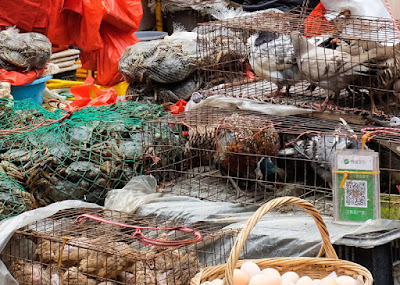If you learned of places where people are confined to crates for most of their lives, what would you say (after your first yelp of disbelief and indignation)?
“OMG,
people are sentient beings, and they’re ‘able to perceive and feel things’ –
that’s horrible to do to them, and it must stop!”
Well,
the very same thing happens to some animals, who are equally sentient beings –mother
pigs and baby calves, to be specific.
They are well aware of their confinement, and they are suffering pain, discomfort and depression . . . indefinitely.
If
that’s not a life you’d wish on humans, why are you allowing it to happen to
innocent animals?
Mother
pigs can be confined in “gestation crates” after they’re artificially inseminated
to live out their pregnancies, unable to turn around or lie down or, after
about 16 weeks, mother their babies.
Does that sound sufficiently barbaric?
Calves can be confined to so-called “veal crates,” cruelly named for the end-product those calves will become after their short lives. Unable to move around or play or experience real calf life, these babies live only to be slaughtered and turned into food for people who rave over their muscle-free tenderness.
Does
that sound sufficiently barbaric?
APLNJ & Coalition
The Animal Protection League of New Jersey
(APLNJ.org), a member of the New Jersey Gestation Crate Ban Coalition, shares an
alert and helpful tips about current state legislation:
A5236/S3401 would ban cruel gestation and veal crates in New Jersey and allow mother pigs and baby calves enough space to turn around freely, lie down, stand up and fully extend their limbs.
Ten U.S. states, Canada and the European Union have outlawed this abuse. It's time for New Jersey to take a stand and take action.
Please phone your Senator and two
Assembly members and ask them to cosponsor and support A5236/S3401 to
ban gestation and veal crates.
Sample phone call script: "As your constituent, I am calling to ask you to please cosponsor and support A5236/S3401 to ban cruel caging of farm animals in New Jersey."
After making your call, please send a follow-up message.
Sample email letter: Subject line: A note from your constituent - please support A5236/S3401 to ban gestation and veal crates in New Jersey
Dear Legislator,
As your constituent, I strongly encourage you to cosponsor and support A5236/S3401, which would ban gestation and veal crates within our state. Gestation crates virtually immobilize mother pigs for nearly their entire lives. The crates are so small mother pigs can't even turn around or take more than a step forward or backward. Because of this lack of movement, they suffer muscle and bone deterioration that often leads to debilitating injuries.
Veal crates are similarly cruel. Within days or even hours of birth, calves raised for veal are taken away from their mothers and locked in these crates, which are so tiny the animals can barely move.
Please stand against animal abuse and prohibit the cruel practice of immobilizing mother pigs and baby calves in New Jersey by cosponsoring and supporting A5236/S3401.
Thank you for your consideration. / Sincerely, . . .
Squirrels redux
We looked in vain for squirrels during recent snow storms, wondering what was up. An area “amateur” naturalist commented: Squirrels’ tails are like blankets, and they will hole up in cozy dens in hollow trees or abandoned woodpecker nests.
Any animal active in the winter is probably living on some body fat, but squirrels [also] store a lot of food. They can smell buried nuts even through a foot of snow, and will tunnel under the snow if they get a good whiff.
“It’s all about food,” she said, and sure enough: once we could get outside again with “squirrel snacks,” our neighborhood pals reappeared.
#
You’re
welcome to comment at 1moreonce.blogspot.com.





















